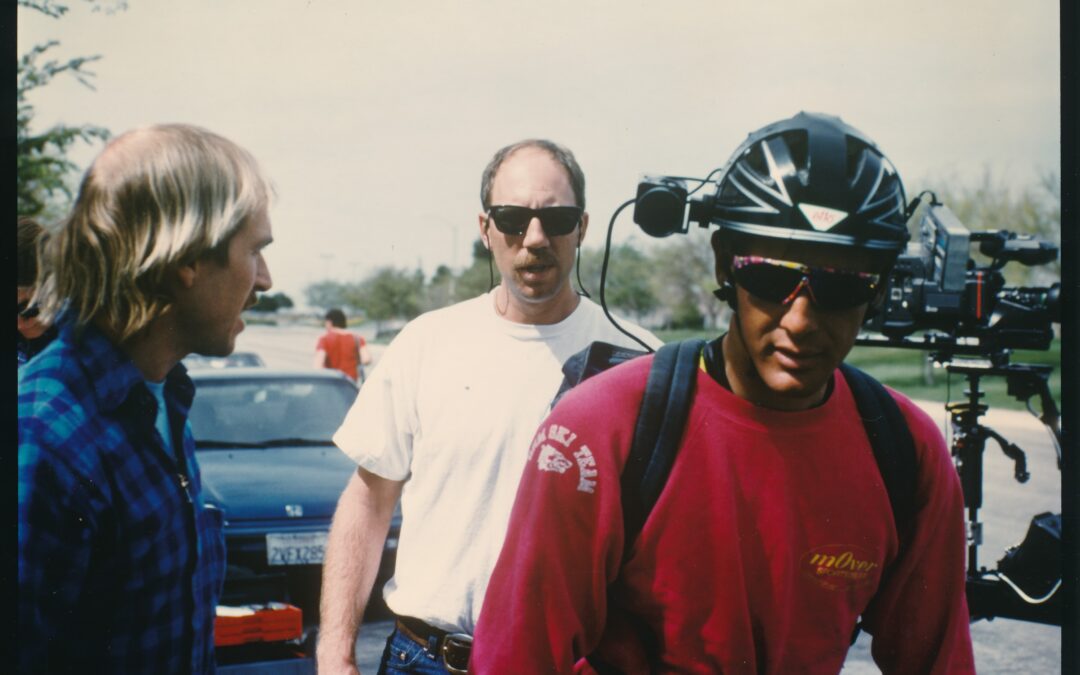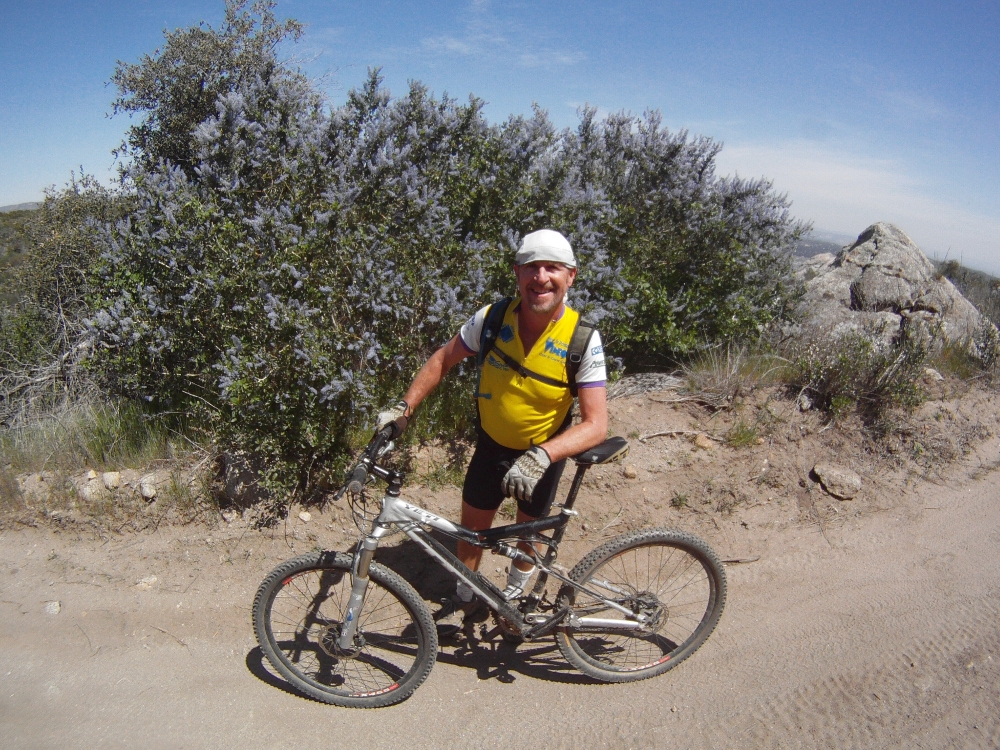Mountain Bike Head Cam – A Historical Overview
aka “All Work No Play Make Jack a Dull Boy – Ain’t it the Truth!”
The mountain bike head cam first invented by Mark Schulze in 1987 was merely one notch on a belt marking our progress towards small, lightweight wearable POV cameras leading to today’s GoPros. How do you think inventions such as this come into being? Innovation comes from passion. In a recent appearance at UCSD (the alma mater of both Mark Schulze and Nick Woodman, coincidentally), Nick told the audience that his GoPro invention had arisen from his passion for surfing and his desire to share his Point of View (POV) with others. That is exactly what drove Mark Schulze to develop his mountain bike helmet cam rig.
For Love of Mountain Biking
One of our most longstanding secrets of success is the passion we have for mountain biking. This is a sport that captured our hearts when we were young and full of energy. We’re still so energetic and full of life because of the Dorian Gray painting up in the attic. Ha! Kidding! Really, it’s that we still ride our mountain bikes on those beloved trails that we began panting up and flying down nearly 30 years ago.
It was the mountain bike which in a round-about way dictated what trail we would follow in our career. We leafed through every page in the now defunct Yellow Pages. We then decided that “Video Production” was what we wanted to do.
“The Great Mountain Biking Video”
And because we were so passionate about mountain biking, we produced the world’s first mountain-bike instructional video called “The Great Mountain Biking Video” back in 1987. In it, our DP Mark Schulze rigged up an otherworldly mountain bike helmet cam which captured the world’s first mountain biking POV (Point of View) footage.
“Great Mountain Biking Video” is accessible at Vimeo on Demand. Consequently, you can get a good look at what the sport was like back in the mid 1980’s. Additionally, you’ll get a good laugh. Judging from the incalculable number of videos you can find at Youtube that are all called “Great Mountain Biking” and imitation being the greatest form of flattery, perhaps we should be ecstatic.
Here is a clip of DP Mark Schulze wearing the cumbersome helmet cam rig in a mountain-bike race at Carlsbad in 1988, videotaped by his wife, Patty Mooney.
The earliest known clip shot with a mountain-bike Head Cam occurred at the Mammoth Mountain Kamikaze mountain bike race in 1988. It’s raw and uncut. And a rider named Jeff Detweiler wore it. Keep in mind that at the time, this helmet cam and backpack probably weighed 30 pounds. And you had to be a very good rider to maintain balance wearing the thing.
In early 2018, we ran into Jeff on a local trail. he consented to this short “interview” about his experience wearing the helmet cam contraption while descending Mammoth Mountain back in ’88.
The Video Helmet Cam Invention – From the Independent
The helmet cam has certainly risen to the forefront of popular movie-making over the past couple of decades, especially in sports. Nick Woodman, CEO of GoPro, is now the head of a billion-dollar company, right here in California as thousands of people don their GoPros and go riding, surfing, climbing, flying and descending, and then share their experiences with the world on YouTube, Vimeo, and a plethora of other delivery methods.
London’s “The Independent” featured a retrospective on the history and contemporary uses of the video helmet camera, which includes an interview with our CEO and Director of Photography, Mark Schulze, who is known as an early innovator of the video helmet cam which he invented for use in our mountain bike videos.
Who dares films: Why extreme-sports fans love helmet-mounted cameras
They’re capable of recording your every move. Will Coldwell gets a high-def heads-up.
One sunny day in California, way back in 1987, a young film-maker called Mark Schulze gaffer-taped a camera to his motorcycle helmet, wired it up to a microphone, got on his bike and pressed “record”. Two decades later and thousands of people around the world are making films using high-definition cameras to depict their adventures exactly as they see them.
But unlike Schulze’s original contraption, a DIY affair that was crude, bulky and heavy, helmet cameras are now mass-produced by global brands such as GoPro, Contour and Drift. Consequently, clipping a camera to yourself and filming has become surprisingly straightforward.
“I Didn’t Patent the Combination”
Unfortunately for Schulze, he’s not the one cashing in on its success. “I didn’t patent the combination,” he says, “I was young and I just used this invention for the videos I was creating; the first mountain-biking videos. I really didn’t think about the future applications and possibilities of something like this.”
Without being paid for by the manufacturers, the clips act as advertisements in themselves, the videos inspire people to take their stunts further, explore new angles and, probably most significantly, purchase one.
Success Story – GoPro
GoPro, the body-mounted camera market leader, sold 800,000 units in 2011,making it around $250m (£158m). West London-based Action Camera – one of Europe’s leading retailers in specialist sport cameras – saw growth of around 30 per cent last year.
“Before it was more like CCTV systems. So you would need a remote pack with the camera but as soon as they went HD everyone wanted them,” explains Matt Taylor, marketing manager for Action Camera.
Patrick Rynne, studying for a PhD in Applied Marine Physics at Miami’s Rosenstiel School of Marine and Atmospheric Science, is using GoPro cameras to shoot his extreme sports and wildlife project; Waterlust. Working with a bigger camera, he explains, would be a “disaster”.
Evolution of Extreme Sports Experience
“It certainly has changed the extreme-sports experience. You’re no longer the lone hunter going out, killing the bear and not having anybody to tell about it. Now you can ride alone, do something rad, and share it with all your buddies online.”
The ease at which cameras like the GoPro allow the user to shoot, edit and upload has also been utilized by Jump4Heros, the Royal British Legion Extreme Human Flight Team. They perform base jumps and skydives to raise money for charities supporting the armed forces.
“Being able to strap a few cameras on really changes how we can go about our business,” explains Major Alastair Macartney, who has done more than 6,500 skydives. “We’re now able to get into every household showing the extremes that we go to.”
Since the cameras shoot constantly as you go, the unpredictability of the end footage is another intriguing aspect of this type of filming. One YouTube video shot with a GoPro, seen 13 million times, shows the moment cyclist Evan van der Spuy collides with a galloping antelope in South Africa.
What the “Third Eye” aka Helmet Cam Sees
Even Schulze can recall similar experiences when he was experimenting with his original helmet cam. “One time I saw a rattlesnake right in the middle of the trail. And I had to jump my bike over the top so as not to hurt the snake. Little things like that were kind of neat. It was nice to be able to show what it was like afterwards.”
Patrick Rynne explains how shooting in this way means that all the work is in the planning. “Shooting with a regular camera is like hunting with a gun. Whereas shooting with a GoPro is like hunting with a snare. You have to ‘trap’ your shots. You need to think about where to put the camera, how to mount it and try to anticipate what things will look like before they happen.”
His team demonstrated this to excess when they strapped a camera to the dorsal fin of a tiger shark.
Reaching a Wider Audience by Way of the Helmet Camera
But it’s not just adrenalin junkies who are using these cameras. Increasingly they have been reaching a wider audience – most notably urban cyclists. They are unlikely to encounter antelopes, rattlesnakes or sharks on their daily commute. However, some would argue they face rather more dangerous threats in the form of bad drivers.
Gareth Williams, better known as Gaz, runs sillycyclists.com. His blog highlights the mistakes cyclists can make on the road, as well as poor driving. He is part of a small but growing community of around 300 cyclists in the UK. They regularly upload and blog about videos they have made using helmet cameras.
Using a Countour Roam camera, Williams began filming in 2009 after a road accident that resulted in a drawn-out battle with his insurers. “With the helmet cam there’s no debate – they just pay up”.
But, as Williams explains, it’s not just about capturing calamitous crashes. “Sometimes we put up a video to show a really nice ride. Like a journey where it’s green lights all the way.”
Meanwhile, Schulze is content to know that his idea has spread, while the motivation driving people to make such films remains unchanged. “The point of view aspect is what it was all about then. And it’s what it’s all about now – people just want to show off what they do.”
The Earliest Known Clip Shot with a Helmet Cam
Patty Mooney is a VP, Video Producer, Video Editor, Sound Technician, Teleprompter Operator and Voice Over at Award-Winning San Diego Video Production Company, Crystal Pyramid Productions.









